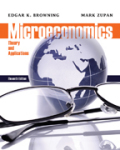
INDICE: Preface v Acknowledgments x Chapter 1: An Introduction to Microeconomics 1 1.1 The Scope of Microeconomic Theory 2 1.2 The Nature and Role of Theory 2 1.3 Positive versus Normative Analysis 4 1.4 Market Analysis and Real versus Nominal Prices 5 1.5 Basic Assumptions about Market Participants 61.6 Opportunity Cost 6 1.7 Production Possibility Frontier 10 Chapter 2: Supply and Demand 15 2.1 Demand and Supply Curves 16 2.2 Determination of Equilibrium Price and Quantity 23 2.3 Adjustment to Changes in Demand or Supply 25 2.4 Government Intervention in Markets: Price Controls 28 2.5 Elasticities33 2.6 The Mathematics Associated with Elasticities 42 Chapter 3: The Theoryof Consumer Choice 48 3.1 Consumer Preferences 50 3.2 The Budget Constraint59 3.3 The Consumers Choice 63 3.4 Changes in Income and Consumption Choices 68 3.5 Are People Selfish? 74 3.6 The Utility Approach to Consumer Choice 77 Chapter 4: Individual and Market Demand 85 4.1 Price Changes and Consumption Choices 86 4.2 Income and Substitution Effects of a Price Change 91 4.3 Income and Substitution Effects: Inferior Goods 96 4.4 From Individual to MarketDemand 99 4.5 Consumer Surplus 101 4.6 Price Elasticity and the PriceConsumption Curve 107 4.7 Network Effects 109 4.8 The Basics of Demand Estimation 113 4.9 Deriving the Consumers Demand Curve Mathematically 117 Chapter 5: Using Consumer Choice Theory 122 5.1 Excise Subsidies, Health Care, and Consumer Welfare 123 5.2 Subsidizing Health Insurance: ObamaCare 128 5.3 Public Schools and the Voucher Proposal 133 5.4 Paying for Garbage 137 5.5 The ConsumersChoice to Save or Borrow 141 5.6 Investor Choice 147 Chapter 6: Exchange, Efficiency, and Prices 158 6.1 Two-Person Exchange 159 6.2 Efficiency in the Distribution of Goods 165 6.3 Competitive Equilibrium and Efficient Distribution 169 6.4 Price and Nonprice Rationing and Efficiency 173 *6.5 Some of the Mathematics behind Efficiency in Exchange 176 Chapter 7: Production 180 7.1 Relating Output to Inputs 181 7.2 Production When Only One Input Is Variable: The Short Run 182 7.3 Production When All Inputs Are Variable: The Long Run 189 7.4 Returns to Scale 194 7.5 Functional Forms and Empirical Estimation ofProduction Functions 197 *7.6 The Mathematics behind Production Theory 201 Chapter 8: The Cost of Production 207 8.1 The Nature of Cost 208 8.2 Short-Run Cost of Production 209 8.3 Short-Run Cost Curves 213 8.4 Long-Run Cost of Production 218 8.5 Input Price Changes and Cost Curves 224 8.6 Long-Run CostCurves 227 8.7 Learning by Doing 230 8.8 Importance of Cost Curves to Market Structure 232 8.9 Using Cost Curves: Controlling Pollution 234 8.10 Economies of Scope 237 8.11 Estimating Cost Functions 238 *8.12 The Mathematics behind Production Cost 240 Chapter 9: Profit Maximization in Perfectly Competitive Markets 245 9.1 The Assumptions of Perfect Competition 246 9.2 Profit Maximization 248 9.3 The Demand Curve for a Compe
- ISBN: 978-1-118-06554-9
- Editorial: John Wiley & Sons
- Encuadernacion: Cartoné
- Páginas: 640
- Fecha Publicación: 06/10/2011
- Nº Volúmenes: 1
- Idioma: Inglés
